"Modern Nighthawks of 2025": When film photography bridges 83 years of urban solitude
Fine Art print available, inadvertently inspired by Edward Hopper.
It was freezing cold. I had left a show in Brooklyn, and on my way back through Hoboken, New Jersey, I passed Basile’s Pizza. The warm glow stopped me in my tracks.
I pulled out my camera and shot three frames, adjusting the angle each time. I composed the scene carefully, placing the man watching television in the center of the second-to-last window pane. Shooting from the street, I framed him through the glass, surrounded by the orange tile walls and empty chairs. The shadows from inside the pizzeria stretched across the sidewalk, and I knew I wanted to preserve that in the final image.
The film was CineStill 800T. As we know, the tungsten-balanced stock transforms night scenes into something cinematic. The halation effect creates that signature red glow around lights (which was not the case in this photo, by the way). The color grading you see here comes straight from the film with minimal editing. I adjusted the shadows to emphasize those cast on the ground, but the teal-and-orange palette is pure film magic.
When I first looked at the developed image, I knew I had captured something beautiful. But I had no idea how deeply it connected to art history, until I showed it to two photographer friends (reference!), who instantly told me the picture reminds them of Hopper…
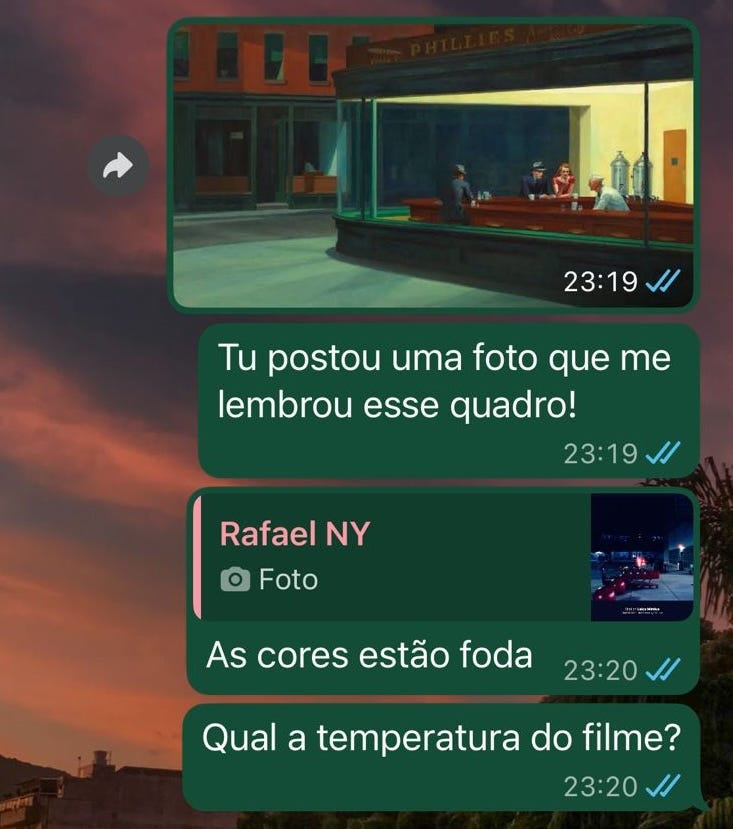
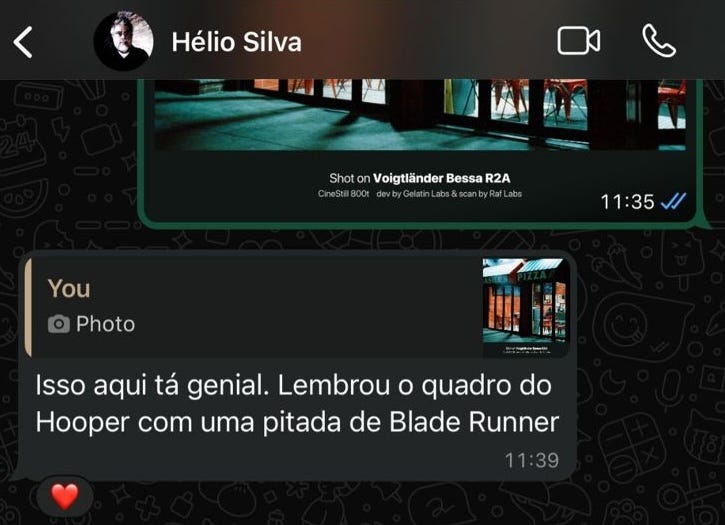
I went home and Googled for "Hopper”, and what I found shocked me, because the visual similarity was striking, but the conceptual parallel ran even deeper…
The Nighthawks Legacy
Edward Hopper painted “Nighthawks” (oil on canvas) in 1942, and it became one of the most iconic images in American art. Four people occupy a latenight diner: a server, a couple, and a lone man with his back to us. They share the same physical space, yet each remains trapped in private isolation. The glass wraps around them like an aquarium. The street outside holds no detail, no life, nothing except the void of a closing-time city.
Hopper said he was “painting the loneliness of a large city.” He captured something essential about urban existence: you can be surrounded by people and still feel completely alone.
When I look at my photograph next to Hopper’s painting, which I did without knowing it, I see the same punctum, the same core idea, translated across 83 years. We both captured four people.
In Hopper’s diner: the server, the couple, the solitary man.
In my pizzeria: the server, the customer, and two basketball players on the television screen.
Both images express profound loneliness. But the sources of that isolation have evolved.
In 1942, Hopper’s figures sit disconnected in analog silence. No phones. No screens. No digital escape routes. Their loneliness comes from physical proximity without emotional connection. They occupy the same room but inhabit separate worlds, divided by nothing more than the space between bodies and the inability to bridge it.
In 2025, my photograph shows how digital media has become the new barrier. The customer wears headphones, his ears occupied by one form of media while his eyes consume another on the television. He watches a basketball game, two athletes performing for millions of invisible viewers. The server stands in his corner, probably scrolling through a phone. An ATM waits nearby, ready to facilitate another transaction without human interaction.
My message is that the world hasn’t changed much since Hopper painted that diner in 1942. We still seek warmth and light. We still gather in public spaces. We still end up alone despite the crowd. The only difference is that now we carry our isolation devices with us.
Recently, I watched a YouTuber called Jason Kummerfeldt (a.k.a. Grainy Days), who is a fan of Hopper, and is always discussing how “Nighthawks” serves as a touchstone for so many photographers, including himself.
Jason is right. The painting has become a visual reference point because Hopper understood something timeless about urban loneliness. That understanding translates across decades, across mediums, from paint to social media.
I had never studied Hopper when I made my photograph. I responded instinctively to what I saw through the rangefinder. The connection emerged only after someone else recognized it. This taught me that certain visual truths transcend individual intention. We tap into shared vocabularies of loneliness and light without conscious effort.
Available as a Fine Art Print in A3+ (13 x 19”)
Modern Nighthawks of 2025 is now featured as a fine art print in Camera Clara. I am thrilled to offer it to people who appreciate the intersection of film photography, urban documentary, and art history.
I print each one myself with meticulous attention to color calibration. This print is available in A3+ Premium Fine Art Smooth Photo Paper (13 x 19” size), ensuring the rich tones and subtle details translate beautifully to physical form, as well as a nice size to appreciate all the grain and details.
If you have ever walked cold city streets and felt drawn to the warmth of a lit window, and if this photograph speaks to you, now may be a moment to have it living on your wall, so you look at it when you're having your Uber Eats alone at a rainy nights, and remember that world hasn't changed.
Available now: Limited edition fine art print, A3+ size, matte fine art paper, printed and color-calibrated.



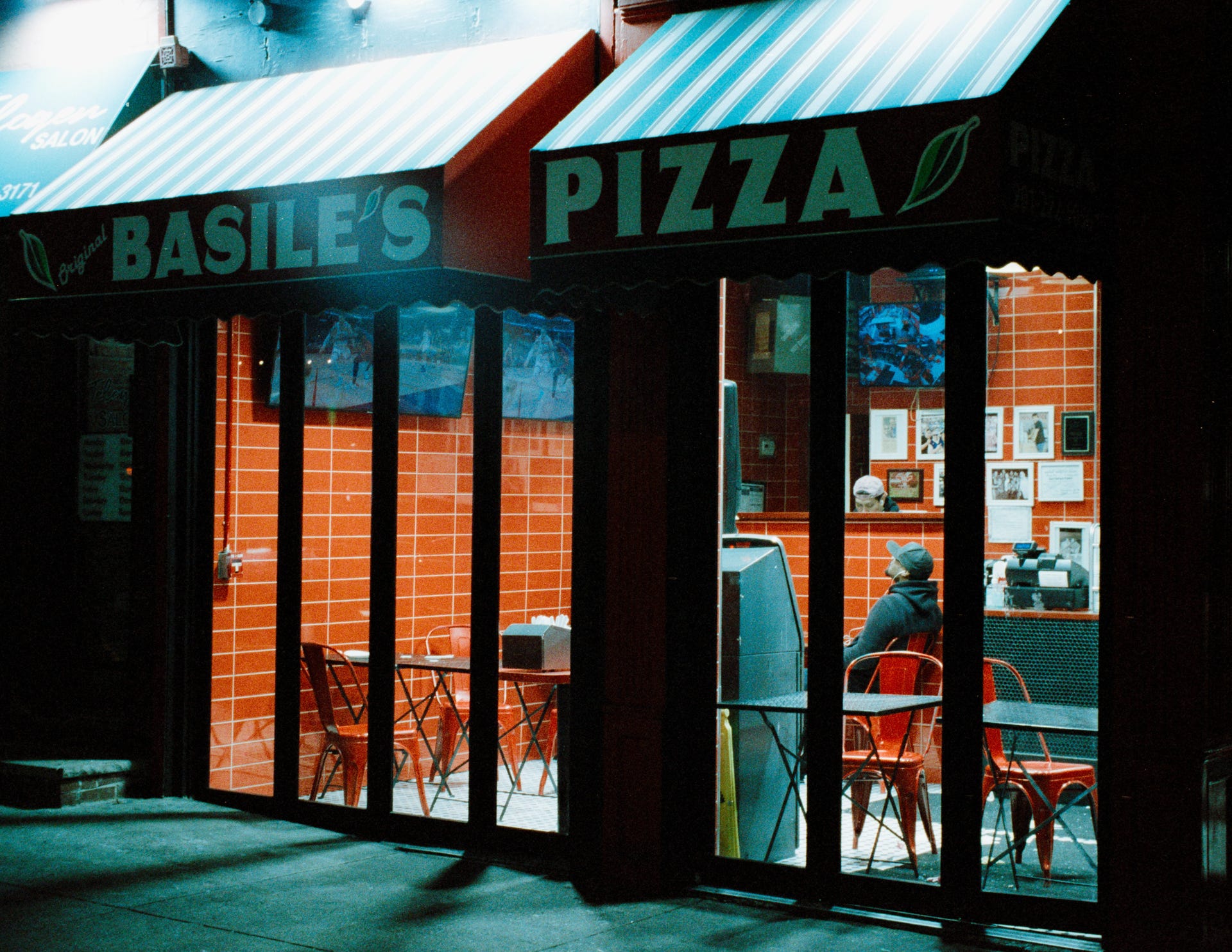

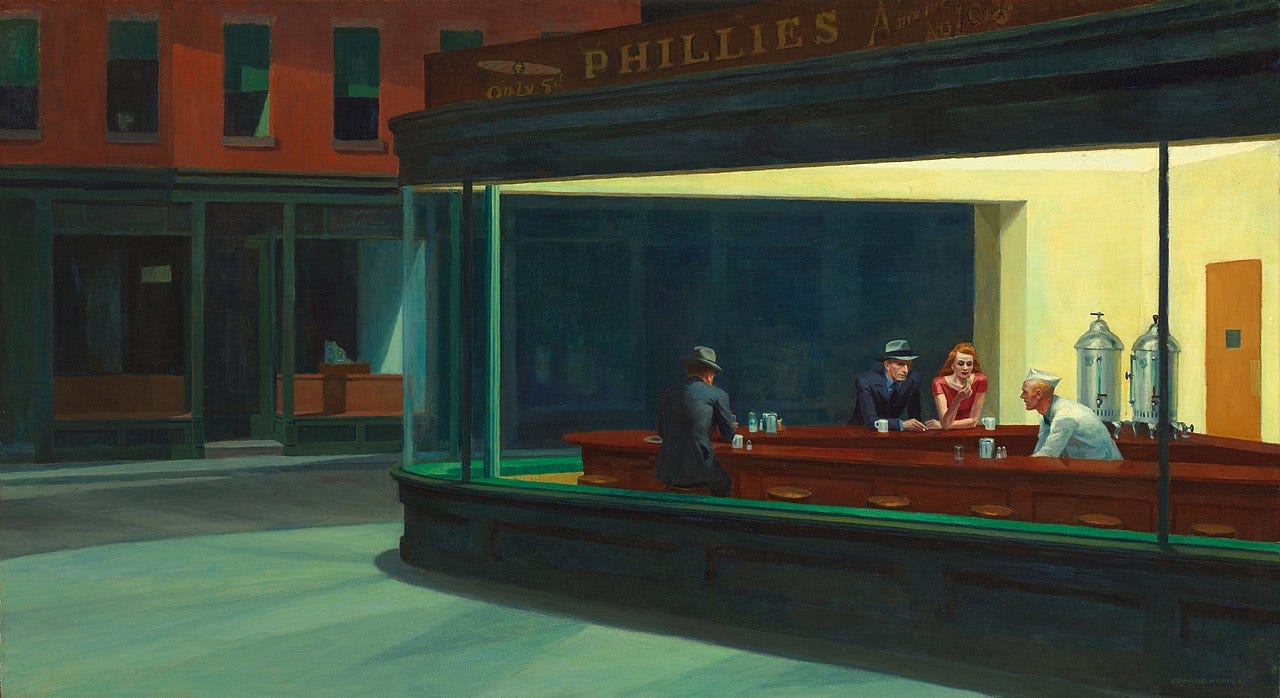

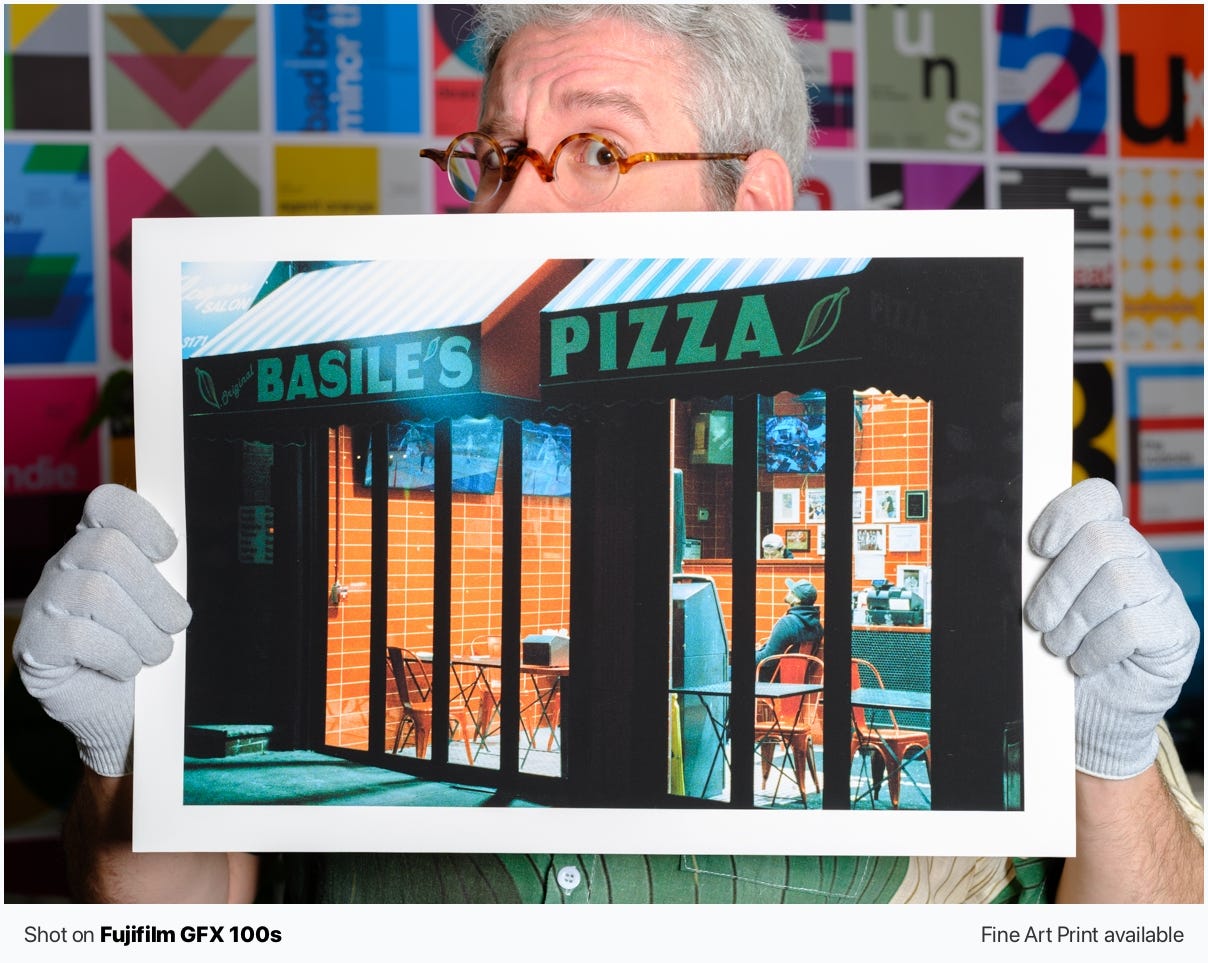
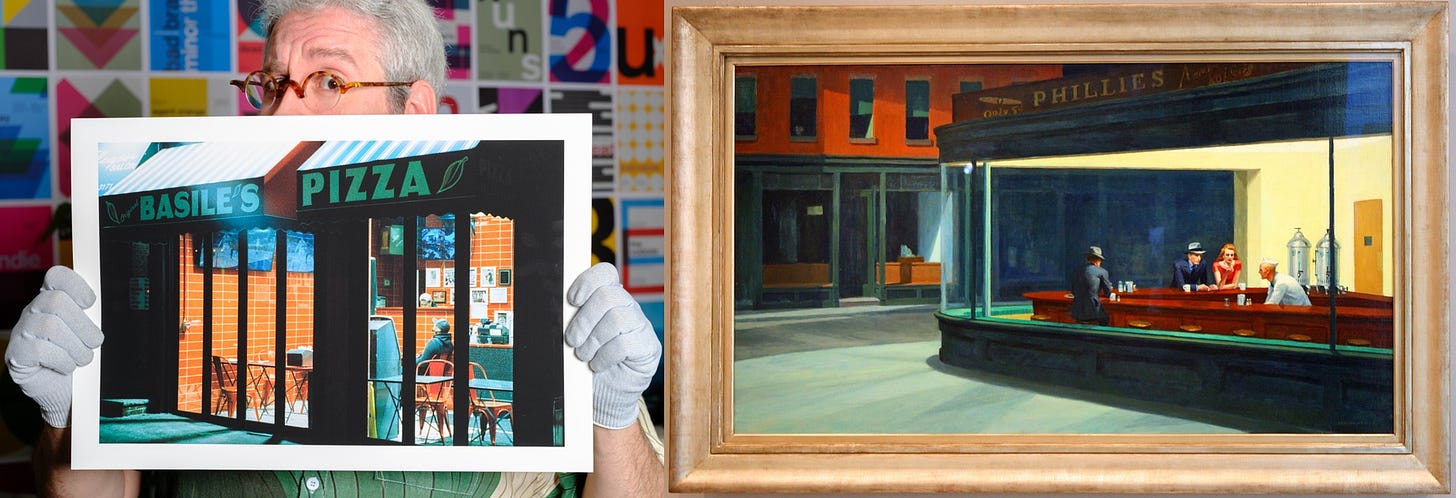

I see Blade Runner references in the glow at the top of the image, along with the tones between green and blue, which is probably due to the movie being shot on film.
The blue light from the TV's screens also leads me to many "external" scenes in the movie.
The rain is unnecessary here; the loneliness comes from the empty spaces fading into the dark, partially illuminated by artificial lights.
The two men's images, framed by the door, added another layer of claustrophobia to the composition. It leads me to Hitchcock's Rear Window, where each window and frame reveals a little about the characters inside.
And yes, the green, the composition, and the perspective quickly led me to Hopper's reference.
This is the magic of art: you do something, and people around you absorb it based on their own culture. Artists give us something to think about, and the spectators become part of the creative process.
The artist releases a spark, and the audience transforms it into a fire that illuminates the human spirit.
I agree with Rafa; it is an unintentional update of Hopper's painting, showing new ways to become alone in the middle of a crowd.
Modernity hasn't changed the human condition.